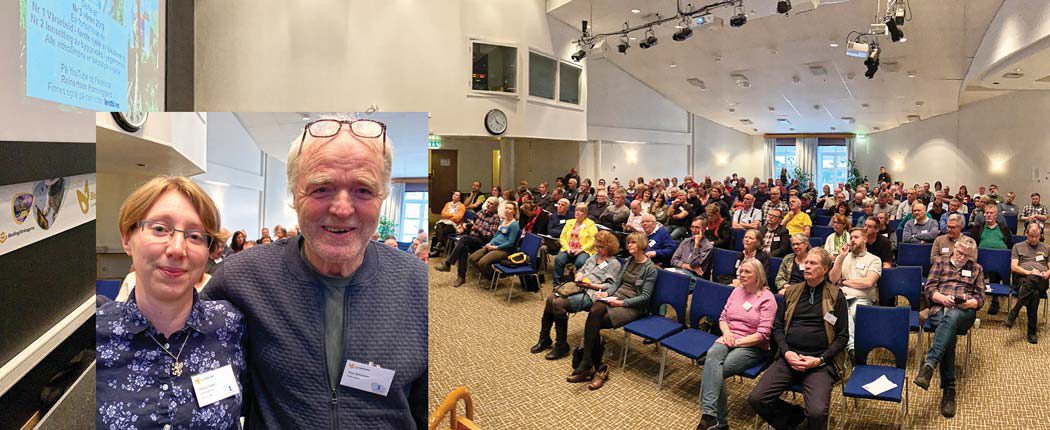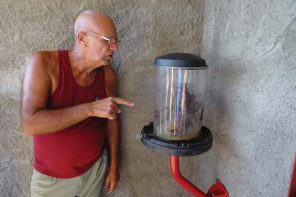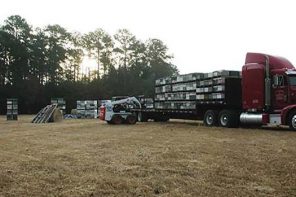By: Erik Osterlund
Dr Melissa Oddie, a Canadian researcher, will continue her research for at least two years based on the Varroa resistant bees with Terje Reinertsen in central Norway. Her doctoral dissertation was based on research with these bees. The Norwegian authorities have allocated $ 1 million (NOK 8.5 million) for this research.
February 21-23 the commercial beekeepers in Sweden (Biodlingsforetagarna)had a conference in Sunne in western Sweden close to the Norwegian border at the newly built hotel Selma Spa. It was fully booked. Beekeepers from Sweden, Norway and some from Finland were listening to Terje and Melissa and many others, from the University of Agriculture in Sweden (SLU), from Belgium and Canada to mention a few. Sunne is the place where Selma Lagerlöf lived, a famous author, the first woman to get the Nobel Prize in literature.
Dr. Oddie discovered a salient trait in Terje Reinertsen’s bees which expresses itself in that bees uncap pupae in which there are mites and recap them again without damaging the pupae. This apparently interferes with the mites’ reproduction. The characteristic that is otherwise very much in focus today is called VSH (Varroa Sensitive Hygiene). Here, the bees remove pupae that are invaded by mites (mites that have offspring). VSH is not a prominent feature of the resistant Norwegian bees.
Visit in Norway
In the Fall of 2019, my wife Gunvi and I visited Anita and Terje Reinertsen. They don’t have a lot of suitable agriculture land for growing crops in Norway so they use every little piece of land possible to grow food. Quite steep slopes had recently been harvested. Norway is no longer Sweden’s little brother as it’s been for many years. It’s the big brother now, with oil and gas and Varroa resistant bees!
The Varroa resistant bees
Some years ago, researchers began to be interested in a population of Varroa resistant bees in Norway around Terje Reinertsen. The important thing is that you don’t have to treat them at all against the Varroa mite, and they are therefore not treated. The mite population in a hive of Terje can vary during the season. His bees haven’t been treated for about 25 years. It was about the time when the mite came to Norway. When I became aware of this, I wondered why we hadn’t heard or read more about his bees during these many years.
Now there has been some exciting research reports from the works of Dr. Melissa Oddie and her coworkers.1,2,3,4 Research on these bees was the basis for her doctoral dissertation. Since then, articles and reports of the bees of Terje Reinertsen have been published.
He has been focused on developing a stock of Varroa resistant bees since the mite began to create problems in Norway. And he has done that together with beekeepers in his vicinity. In April 2019, he was one of the speakers at a conference in southern Sweden on healthy bees that do not need to be treated against parasites and diseases, and how to get there. Melissa Oddie participated, together with several other speakers including Kirk Webster from Vermont. And now in February 2020 he and Melissa Oddie were speaking in Sunne.
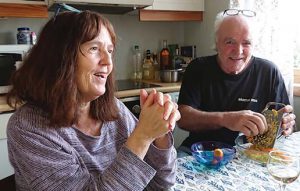
Anita and Terje Reinertsen.
Varroa in Norway
In 1994, the Varroa mite had made its presence so well known among beekeepers in Norway that it was decided that bee colonies had to be treated against the mite. The central association took help from countries where they had had more experience of the mite. Among other things, it was recommended to use ”Krämerplatten” that evaporates formic acid in the bee colony.5
Terje listened carefully to the advice and treated his bees in the recommended way in the Autumn of 1994. He lost 70% of his colonies in the Winter of 1994-95. Other beekeepers also lost about the same amount of beehives. Several lost 100%. Spring treatment with formic acid was then mentioned as an additional alternative to save colonies that survived the Winter. Then fewer holes in the plastic around the formic acid soft board plate were used so that the evaporation speed would not be so high.5 Terje applied this method to the survivors.
Decision not to treat
After analyzing the results of all the treatments, Terje and some other beekeepers concluded that if you were to loose so many bee colonies after treating, you could just as well not treat, because you didn’t lose more colonies if you didn’t treat.

Terje Reinertsen shows a split in September, grown in strength to be ready for Winter and well fed.
At that time, little was known about the importance of the balance between all different types of microorganisms (bacteria, viruses, and other types of microbes) for the immune system. Such an ecological system of microorganisms in and on a living being is called a microbiome. For example, we humans have about 2 kg of microbes on and in us. Without them we die.
Microbiome and epigenetics
The microbiome6 is now a hot topic in research, even among bees7. The microbiome will become unbalanced if chemicals in sufficient quantities affect the bees.8 Defense against harmful microbes is weakened, for example against pathogenic viruses.
Another hot topic in research is epigenetics.9 Changes in how genes in the DNA are used, in kind of a contrast (or rather complement) to how the composition of the genes in DNA are changed through breeding (natural or beekeepers).10 Changes in the environment create changes in the DNA so that some genes are turned off and others turned on.
Purchase of never treated bee colonies
In 1995, Terje compensated for his colony losses by purchasing about 35 bee colonies. These came from an area where the Varroa hadn’t yet arrived so these colonies had never been treated against Varroa. Some of these colonies were splits raising new queens of their own. The new colonies developed well and wintered successfully. These were more in number than those that survived Varroa and formic acid. In the Winter of 1995-1996 and onwards, the losses were again about normal, five to 10 %, despite the lack of Varroa treatment.
Because of the large losses of bees for many beekeepers in the winter of 1994-95, the reinvasion of mites was not a problem for Terje’s bees. He also started at once with the simple breeding concept he has followed through the years since. He focused in various ways to identify the worst and the best bee colonies when it comes to keep down the mite population and being resistant to viruses.
Breeding strategy
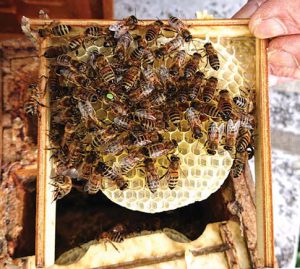
A small mini mating nuc with three mini frames. When the queen is egg laying, Terje harvests it and introduces it in a colony that needs a new queen.
Today Terje Reinertsen doesn’t estimate the varroa level in his colonies. He doesn’t care about Varroa mites anymore. Others have made estimates. And it seems the Varroa levels mainly is 1-3%, with some exceptions at a higher level. The interesting thing is that no signs of virus damage could be seen.
His main traits for selection are
1 – Good temper
2 – High egglaying capacity
Every year he replaces the queens in the worst 30 % of his hives. They are today about 250. Once they were 350. He is retiring age, but he’s working all days. If not with bees, he’s hunting or fishing.
Among the best 10% of his hives he checks the very best. Good hives are of course also giving a good crop. He breeds queens from several of these. He does not regularly replace queens who have grown old. Only when the colonies are bad, whether the queens are young or old. Colonies in the mid range (and the best) are allowed to replace their queens themselves. Young queens are mostly mated in the center of an area where many good colonies of somewhat different heritage are kept. This type of mating system you can call population mating, actually the old type of line breeding where all bees in an area could be called a line. I remember Steve Taber explained what a line really was at the Bee-85 conference in Sweden many years ago. This could be likened with a kind of closed population breeding. In this way, high vitality, good harvest and genetic variation is maintained.
Terje wasn’t sure it was sufficent with the buckfast variety of bees he had initially, so he tried other buckfast types and some other varieties of bees. Today, Terje’s bees could simply be called Terje bees.
Comb foundation
Terje got smaller cell size wax foundation from Hans-Otto Johnsen, a beekeeper colleague. Shortly after the year of 2000 he reduced the cell size to 5.1 mm, then to 4.9 mm. Now he is in the process of setting up his own, almost commercial equipment for manufacturing wax foundation.
Establishment of another Varroa resistant strain
Ten years ago he acquired 14 Norwegian carniolan queens mated in an area with only carniolan bees in Norway. These queens were introduced to splits from Terje bees. The splits were placed with a beekeeper about 60 km from Terje, isolated from other bees. Today, the 14 colonies have grown into a population of about 100 colonies. All new queens (and splits) come from the group and mated in its area. These colonies have never been treated against Varroa. There have always been low Winter losses in this group, which has become kind of a resistant stock. Maybe you can do it this way if you want to produce a Varroa resistant bee stock of a bee variety other than Terje bees.
Terje queens in a different environment
A number of years ago, Terje queens were purchased by some universities in Europe. From Switzerland I have heard results how they managed. They were introduced to colonies of local bees managed in their traditional way. After the introduction of Terje queens, these colonies were not treated against Varroa, and they managed well.
Active in the bee association
Terje has always helped beekeeper colleagues and beginners. He has held beginner courses for many years. And he has helped them with splits and new colonies. He has been the chairman of the local association for 20 years and vice president of the district association for many years. Once a month from April to September, the local association has a club meeting in his garden. There are gathered in average 30-35 people.
The Terje stock
There are now 1500-2000 Terje bee colonies in Norway. There are about 100 beekeepers who have these bees and they do not treat against Varroa. Most of these have their bees in the area where Terje lives, 20 minutes north of Oslo, the capital. One of these beekeepers, has eight colonies and lives on the outskirts of the Terje area. There are many bee colonies other than Terje bees around him. The closest is 200 meters (yards) away.
Tim has done a small measurement study on the daily natural fall of mites during a season. It varies during the season and although from some colonies it can be quite big in May, it is low at the end of the season.
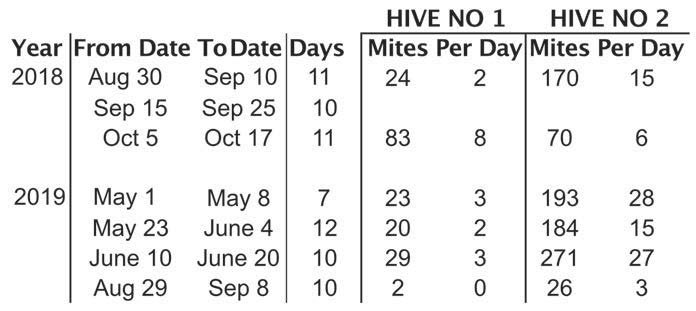
References
1. Oddie, M.A.Y., Dahle, B., Neumann, P. 2017. Norwegian honey bees surviving Varroa destructor mite infestations by means of natural selection. PeerJ 5:e3956 – https://peerj.com/articles/3956
2. Oddie, M.A.Y., Dahle, B., and Neumann, P., Reduced Postcapping Period in Honey Bees Surviving Varroa destructor by Means of Natural Selection, MDPI: Insects 2018, 9(4), 149 – https://www.mdpi.com/2075-4450/9/4/149
3. Oddie, M., Büchler, R., Dahle, B. et al. Rapid parallel evolution overcomes global honey bee parasite. Sci Rep 8, 7704 (2018) doi:10.1038/s41598-018-26001-7 – https://rdcu.be/bZasw
4. Oddie, M.A.Y., Neumann, P. & Dahle, B., Cell size and Varroa destructor mite infestations in susceptible and naturally-surviving honeybee (Apis mellifera) colonies, Apidologie (2019) 50: 1. – https://doi.org/10.1007/s13592-018-0610-2
5. A piece of soft board, drenched in 250 ml 85% formic acid, 15x17x1 cm in size, put in a tight plastic bag with 2 x 10-15 of 15 mm round holes in the plastic for evaporation, described here. – https://wiki.bienenzeitung.de/index.php?title=Kr%C3%A4merplatte
6. https://golden.com/wiki/Microbiome
7. https://mbio.asm.org/content/7/2/e02164-15
8. https://doi.org/10.1073/pnas.1314923110
9. https://en.wikipedia.org/wiki/Epigenetics_in_insects
10. https://www.whatisepigenetics.com/the-epigenetics-of-honeybee-memory-offers-a-glimpse-into-our-own-minds/; https://doi.org/10.3389/fnmol.2016.00082






